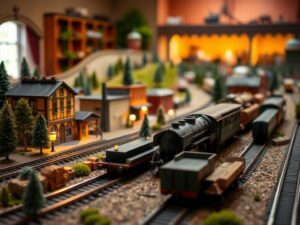How to Troubleshoot Electrical Issues in HO Scale Layouts
How to Troubleshoot Electrical Issues in HO Scale Layouts
How to Troubleshoot Electrical Issues in HO Scale Layouts
Howdy fellow railfans! Today we’re diving headfirst into a common challenge that every model railroader faces at some point: electrical issues. Whether itâs a stubborn locomotive refusing to budge, flickering lights, or a sudden power outage on your beautiful HO scale layout, troubleshooting these problems can seem daunting.
Fear not! This comprehensive guide will walk you through the most frequent electrical problems in HO scale layouts, break down their causes, and equip you with the knowledge and techniques to fix them. From beginner basics to advanced solutions, we’ve got you covered!
Understanding Your Layout’s Electrical System
Before we delve into troubleshooting, letâs quickly review the fundamentals of your HO scale layoutâs electrical system:
- Power Supply: This is the heart of your system, delivering electricity to your track and accessories. Most modelers use a dedicated transformer with adjustable voltage output, tailored for DC (direct current) operation in HO scales.
- Wiring: Conductors are used to distribute power throughout your layout. This includes both feeder wires running from the power pack to the track, as well as jumper wires connecting various sections of the layout and controlling accessory circuits.
- DCC (Digital Command Control) or DC (Direct Current): DCC systems offer individual control over locomotives, lights, and accessories using a command station, decoder boards, and specialized track wiring. In contrast, traditional DC layouts utilize a single power source and controls to operate everything collectively.
Common Electrical Problems in HO Scale Layouts
- No Power at All:
-
Causes:
- Loose connections between the power pack and the layout’s input.
- Blown fuse in the transformer or a tripped breaker in your electrical system.
- Faulty transformer: A malfunctioning power supply will completely shut down power to the layout.
-
Solutions:
- Carefully check all connections â power cords, track connectors, and wires to ensure secure contacts. Tighten any loose connections using appropriate tools like wire strippers and crimpers.
- Examine the transformer for a blown fuse (usually marked F) or reset a tripped breaker on your main circuit panel.
- If the transformer shows no signs of obvious problems, it might be defective and require replacement.
- Power Loss in Specific Areas:
-
Causes: Open circuits within feeder wires due to damage, fraying, or poor soldering. Broken track sections. Obstructions interrupting current flow in track connections.
-
Solutions:
- Carefully inspect feeder wires for breaks or cracks along their length and at their connections to the track. Replace any damaged wiring using proper wire gauges (check your transformer specifications). Ensure soldering joints are clean and well-connected.
- Thoroughly check all track sections for secure alignment and connections. Retighten screws or clips holding track pieces together, ensuring a good electrical connection. Look for anything that could be shorting the circuit.
- Erratic Operation:
- Causes: Short circuits between the rails (live wires touching). Improper grounding, leading to stray current flowing. Overloading circuits beyond their capacity. Interference from electronic devices.
- Solutions:
- Isolate and Address Short Circuits: Remove sections of track and power them separately to pinpoint the faulty area. Replace damaged wire insulation or check for debris obstructing the track. Repair broken wires with heat-shrink tubing or wire nuts, ensuring secure connections.
- Ground Properly: Ensure all metallic parts are securely grounded using grounding straps or screws connected to a designated ground point. This helps divert stray currents and reduces electrical noise.
- Manage Load: Be mindful of how many trains and accessories you operate simultaneously. Avoid overloading circuits â if possible, distribute power across multiple sections with additional transformers or feeders.
- Minimize Electromagnetic Interference: Consider using shielded wires for high-current circuits, keeping wiring away from sensitive electronic components, and testing with an electrical tester to check for interference.
- Train Problems (Non-Electrical):
While this blog post focuses on HO scale electrical troubleshooting, keep in mind that sometimes, non-electrical issues can mimic electrical problems:
* Worn wheels or trucks can lead to inconsistent pickup, making it seem like a power issue. Clean your wheels regularly with alcohol and use fine sandpaper to remove any build-up.
Essential Tools for Troubleshooting:
To tackle these common issues effectively, assemble these essential tools:
* Multimeter: An indispensable tool for measuring voltage, current, and resistance in your circuits. This helps identify dead circuits, short circuits, and broken connections.
* Wire Strippers/Cutters: Cleanly remove insulation from wires to create reliable connections.
* Solder Iron & Soldering Accessories (Flux Core & Solder): Use solder and a properly heated iron for creating strong electrical joints â crucial for permanent repairs and track construction.
* Screwdrivers (Various Sizes): For tightening connections, removing screws, and working with terminals.
Tips and Insights for Successful HO Scale Electrical Troubleshooting:
- Safety First!: Always disconnect your layout’s power supply before making any adjustments or repairs.
Never touch live wires or circuits â shock can be dangerous! Work on a non-conductive surface to avoid ground faults. -
Isolate the Problem: Break down the problem into smaller parts. Disconnect sections of the track and feeders systematically, checking voltage readings along the way, to pinpoint where the fault originates.
-
Label Everything!: As you troubleshoot, clearly label wires, feeders, and components with their functions â this will save you headaches later.
- Documentation: Record your steps and findings as you work â it helps track your progress, identify patterns in problems, and avoid repeating the same mistakes.
-
Remember, fellow model railroad enthusiasts, every expert started as a beginner! Troubleshooting electrical issues can be challenging, but with patience, systematic problem-solving, and these helpful tips, youâll master your layoutâs power system in no time.
Happy Railfanning!




